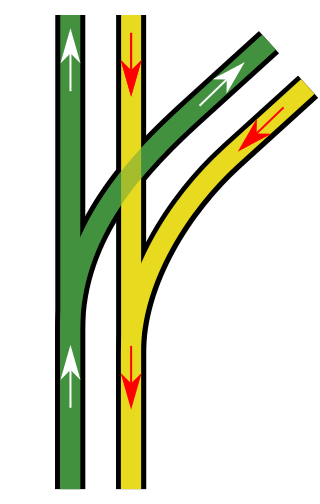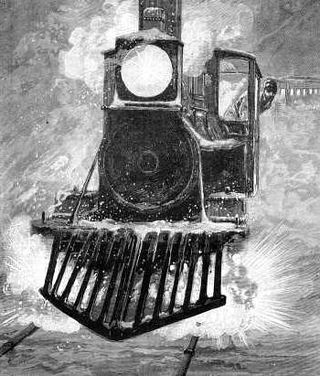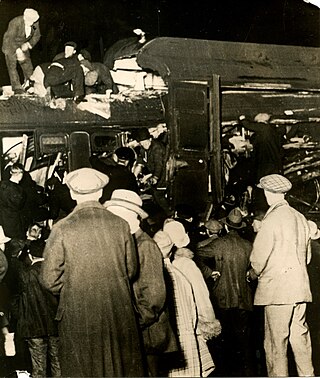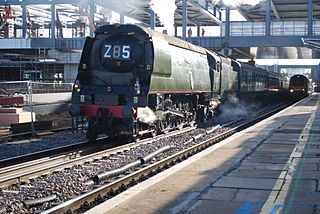Related Research Articles

A conductor or guard is a train crew member responsible for operational and safety duties that do not involve actual operation of the train/locomotive. The conductor title is most common in North American railway operations, but the role is common worldwide under various job titles. In Commonwealth English, a conductor is also known as guard or train manager.

Railway signalling (BE), or railroad signaling (AE), is a system used to control the movement of railway traffic. Trains move on fixed rails, making them uniquely susceptible to collision. This susceptibility is exacerbated by the enormous weight and inertia of a train, which makes it difficult to quickly stop when encountering an obstacle. In the UK, the Regulation of Railways Act 1889 introduced a series of requirements on matters such as the implementation of interlocked block signalling and other safety measures as a direct result of the Armagh rail disaster in that year.
The Train Protection & Warning System (TPWS) is a train protection system used throughout the British passenger main-line railway network, and in Victoria, Australia.

A signal passed at danger (SPAD) is an event on a railway where a train passes a stop signal without authority. This is also known as running a red, in the United States as a stop signal overrun (SSO) and in Canada as passing a stop signal. SPAD is defined by Directive 2014/88/EU as any occasion when any part of a train proceeds beyond its authorised movement. Unauthorised movement means to pass:

The Southall rail crash occurred on 19 September 1997, on the Great Western Main Line at Southall, West London. An InterCity 125 high speed passenger train (HST) failed to slow down in response to warning signals and collided with a freight train crossing its path, causing seven deaths and 139 injuries.

The Colwich rail crash occurred on the evening of Friday 19 September 1986 at Colwich Junction, Staffordshire, England. It was significant in that it was a high-speed collision between two packed express trains. One driver was killed, but no passengers died because of the great strength of the rolling stock involved, which included Mk1, Mk2 and Mk3 coaches.

The Harrow and Wealdstone rail crash was a three-train collision at Harrow and Wealdstone station in Wealdstone, Middlesex during the morning rush hour of 8 October 1952. The crash resulted in 112 deaths and 340 injuries, 88 of these being detained in hospital. It remains the worst peacetime rail crash in British history and the second deadliest overall after the Quintinshill rail disaster of 1915.

The railway signalling system used across the majority of the United Kingdom rail network uses lineside signals to control the movement and speed of trains.

Rule 55 was an operating rule which applied on British railways in the 19th and 20th centuries. It was superseded by the modular rulebook following re-privatisation of the railways. It survives, very differently named: the driver of a train waiting at a signal on a running line must remind the signaller of its presence.

A double junction is a railway junction where a double-track railway splits into two double track lines. Usually, one line is the main line and carries traffic through the junction at normal speed, while the other track is a branch line that carries traffic through the junction at reduced speed.

A railway detonator, or fog signal is a coin-sized device that is used as a loud warning signal to train drivers. It is placed on the top of the rail, usually secured with two lead straps, one on each side. When the wheel of the train passes over, it explodes, emitting a loud bang. It was invented in 1841 by English inventor Edward Alfred Cowper.

The Bellgrove rail accident occurred on 6 March 1989 when two passenger trains collided near Bellgrove station, Glasgow, United Kingdom. Two people were killed and 53 were injured. The cause was driver error, with a signal being passed at danger. The layout of a junction was a contributory factor.

The Paisley Gilmour Street rail accident occurred on 16 April 1979 at 19:50. The 19:40 Inverclyde Line service from Glasgow Central to Wemyss Bay, operated by two Class 303 trains, crossed from the Down Fast Line to the Down Gourock Line under clear signals at Wallneuk Junction immediately to the east of Paisley Gilmour Street railway station. It collided head-on with the 18:58 Ayrshire Coast Line special service from Ayr to Glasgow Central, formed of two Class 126 diesel multiple units, which had left Platform 2 against a red signal P31.

The Darlington rail accident occurred on the evening of 27 June 1928 when a parcels train and an excursion train collided head on at Darlington Bank Top railway station in County Durham, England. The accident was caused by the parcels train driver passing a signal at danger, due to misunderstanding the signalling layout in an unfamiliar part of the station. This accident resulted in the deaths of 25 people and the serious injury of 45 people.

The Cowden rail crash occurred on 15 October 1994, near Cowden Station in Kent (UK), when two trains collided head-on, killing five and injuring 13, after one of them had passed a signal at danger and entered a single-line section. The cause was due to a collective of issues; the AWS being inoperative, the signal was dirty and the light intensity was low, and there were no trap points to prevent a train wrongly entering a section against the signal.

The Spa Road Junction rail crash was an accident on the British railway system which occurred during the peak evening rush hour of 8 January 1999 at Spa Road Junction in Bermondsey, in South East London.

A driver's reminder appliance (DRA) is a manual switch in the driving cab of a passenger train. When operated it glows bright red and prevents the driver from being able to apply power. It was introduced in the design and operation of United Kingdom passenger trains in the 1990s in response to a series of railway accidents where train drivers had passed a signal at danger when starting away from a station.

On 7 March 2015, a steam-hauled charter train passed a signal at danger and subsequently came to a stand across a high-speed mainline junction near Wootton Bassett Junction, Wiltshire, England. Another train, which had right of way, had passed through the junction 44 seconds earlier and no collision occurred nor was any damage done.
Route knowledge is one of the core skills together with train handling and a full understanding of railway rules, which the operating crew must possess in order to be able to operate a train safely.
Automatic Train Protection (ATP) is a method of beacon based railway cab signalling developed by British Rail. The system is only installed on the Great Western Main Line between London Paddington and Bristol Temple Meads, and the Chiltern Main Line from London Marylebone to High Wycombe and Aylesbury.
References
- ↑ Guttmann, Peter (18–23 May 2008). "Ding-ding, and Away!" (pdf). Things that Make us Stupid. AusCERT Asia Pacific Information Security Conference. Gold Coast, Australia. pp. 5–6. Retrieved 10 January 2017– via University of Auckland.
- 1 2 "Online Rulebook - Section TW1 Para 3.6 Bell/Buzzer codes" (PDF). RSSB. Archived from the original (PDF) on 14 September 2016. Retrieved 29 August 2011.
- ↑ Trench, A.C. (9 February 1949). "Report on the Collision which occurred on 18th November 1948, at Woolwich Arsenal Station in the Southern Region (British Railways)" (PDF). Ministry of Transport. p. 5.
- ↑ "Online Rulebook - Section SS1 Para 3.4 The Ready to Start Signal: "Guard, before you begin the train despatch procedure you must ensure that the platform starting signal (if there is one) is showing a proceed aspect"" (PDF). RSSB. Archived from the original (PDF) on 10 August 2018. Retrieved 2 October 2017.
- ↑ "East Coast professional driving policy document: Page 4 - Definitions 'Starting against signal SPAD'" (PDF). East Coast Trains. Retrieved 2 October 2017.